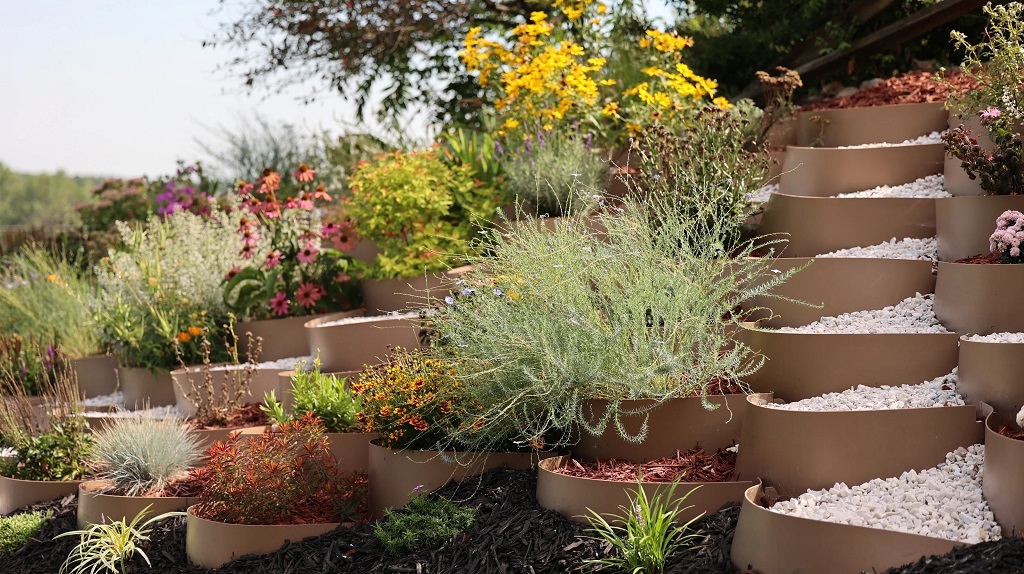Updated: February 10, 2024
There have been few innovations in hillside landscaping technology that have provided both a sound structural solution with an aesthetically pleasing design element in the last few decades.
Hillside homeowners have had few cost-effective options for insuring that dirt and debris from shifting soils, ground movement, rain, or wind did not erode the foundations of their homes, and subsequently cause damage to the structures of their properties.
Thanks to the ingenuity from Dirt Locker, however, homeowners now have an innovative and cost-effective option to strengthen and beautify their surrounding sloped landscapes.
This article explores the landscaping challenges and dangers hillside homeowners face and how Dirt Locker’s solution is a viable DIY erosion control solution for rectifying these problematic hillside landscaping situations.
Table of Contents
- Hillside Soil Erosion and the Danger to Building Structures
- The Challenges of Hillside Landscaping
- Options for Stabilizing Hillsides
- Dirt Locker: Soil Erosion Prevention System
- Steps for Installing a Dirt Locker Landscaping System
- Best Plants for Hillsides and Erosion Control
- Dirt Locker Resources
- Dirt Locker Discount Promo Code
Also see:
Hillside Soil Erosion and the Danger to Building Structures
Each year, many residential structures are threatened as erosion and landslides cause destabilization of the earth around foundations, which eventually leads to structural damage around homes. Evidence of slope slippage can be seen in:
- Uneven flooring
- Doors and windows that no longer close, and
- Cracks in walls and ceilings
Soil slippage, or landslides, happen when the slope of the hillside begins to steepen (i.e. increase), as rains, high winds, and other natural phenomenon occur, such as unstable terrain collapsing due to gravity. In the most extreme cases, a home can be red-tagged, (a classification of being uninhabitable due to being in a dangerous state of disrepair), when falling off its foundation, and must eventually be demolished.
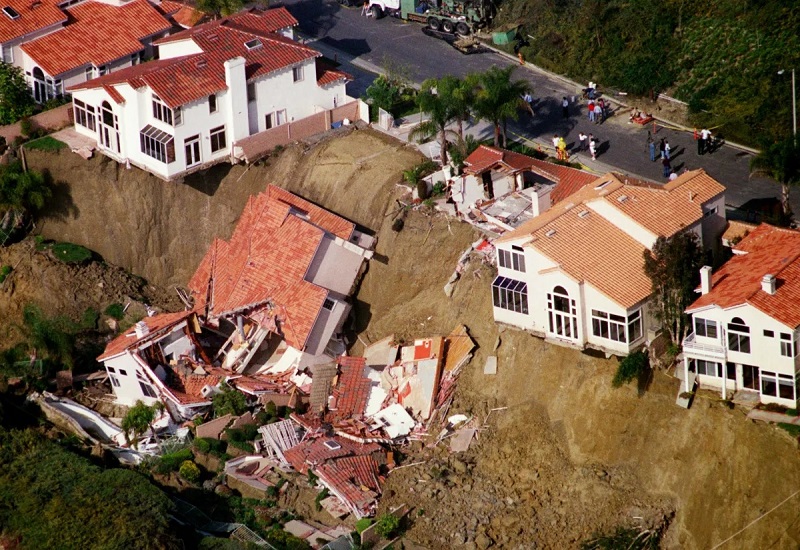
The aftermath of two homes that fell in 1998 when a rain-soaked hillside collapsed on Via Estoril in Laguna Niguel, California.
Photo courtesy of Geraldine Wilkins–Kasinga and the Los Angeles Times.
However, earth movements, such as landslides, can be mitigated and prevented. Since land displacement is a naturally occurring phenomenon, being proactive is a good idea especially since there are cost-effective options to prevent a worsening situation.
Coincidentally, a mudslide occurred nearby in Southern California a few days after this article was originally published.
Video courtesy of KTLA 5 News.
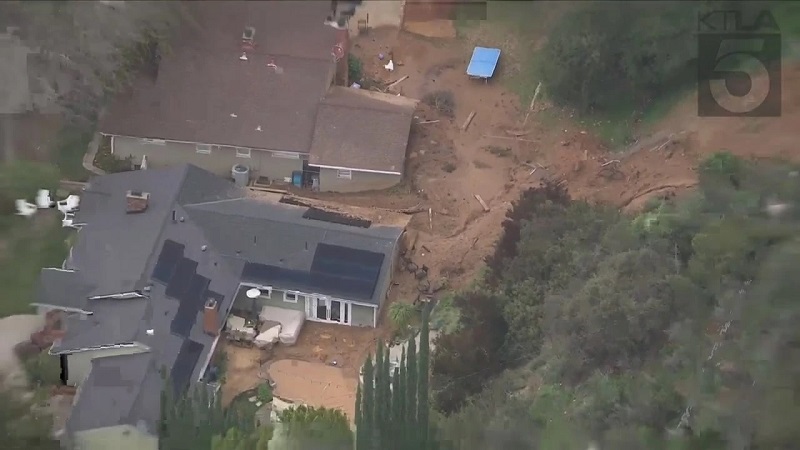
Photo courtesy of KTLA 5 News.
The Challenges of Hillside Landscaping
Depending on the degree of slope, a hillside can vary from a Moderate Slope of 0 to 8.5 degrees to a Severe Slope 31 to 45 degrees, and anywhere in between.
- Flat to Moderate Slope: 0° to 8.5°
- Strong Slopes (True Hillside): 8.5° to 16.7°
- Very Strong Slopes: 16.7° to 24.2°
- Moderately Severe Slopes: 24.2° to 31°
- Severe Slopes: 31° to 45°
Landscaping a hillside is not an easy endeavor and maintaining the infrastructure can prove challenging over time. However, using landscaping to shore-up the natural cohesion of a hillside slope is the best defense against topsoil erosion. It is a lack of cohesion that will lead to an increase in slope stress, strain, displacement, and ultimately landslides.
Hillsides with dense plants that have deep roots to hold the soil are fortresses against heavy rains and strong winds.
However, getting that lush, healthy look on a hillside can often be difficult and expensive. Sloped land has drainage issues, as water naturally runs off more rapidly instead of soaking into the earth, maintaining necessary water and nutrients to nurture young plant roots. Initial installation of plant material and soil together with maintenance and upkeep can all be difficult due to the steepness and instability of the terrain.
Options for Stabilizing Hillsides
Many homeowners opt for the usual solutions to stabilize their hillside terrains, such as:
- Masonry retaining walls
- Wire-mesh covered with either burlap or jute erosion control blankets
- Gunite or shotcrete sprayed hillsides
Masonry walls can be very expensive and must be well designed and constructed. In many jurisdictions, a permit is required for any new or reconstructed masonry retaining wall.
Once built, the masonry must be maintained annually, usually repainting, or patching of cracks or replacing of damaged cinder blocks, depending on the circumstances. Over time, masonry walls lose their strength due to material degradation caused by air pollutants, salts, mineral decomposition and other environmental factors.
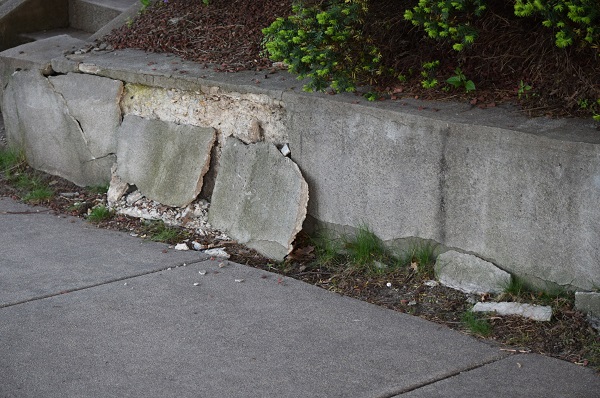
Masonry walls are not fans of mature trees, as eventually tree roots will push against the masonry brick causing an eventual collapse.
Wire mesh with burlap or jute blankets, do not last more than 2-3 years and will eventually decompose from the UV light and rain, thus leaving you with the same problem and thousands of dollars less than before the project started.
While the plants are in their seedling stage, the result is not particularly attractive, as it will take several years for the plants to become firmly rooted into the earth. During this period, the soil is still very fragile and maintenance and upkeep are impossible until the plants mature.
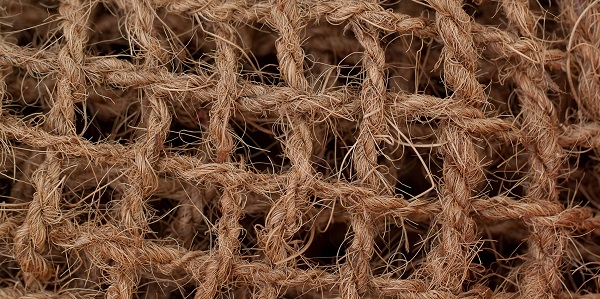
Neither option allows you to maintain the landscaping immediately once it has been installed. Pruning, weeding and fertilizing are still necessary for hillside plants to flourish, as they must still be accessible.
Gunite sprayed hillsides can be an effective solution for hillsides with severe slopes, but lack in aesthetic appeal.
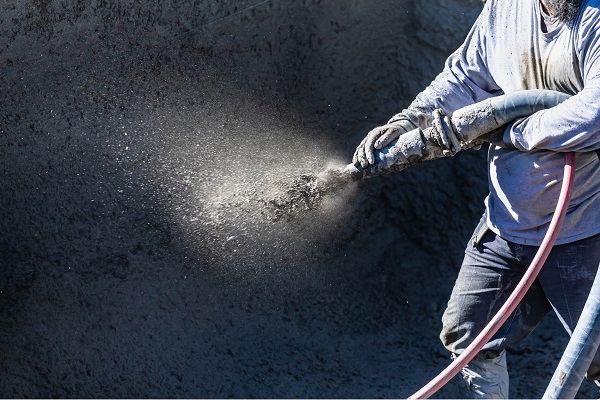
The key to good soil erosion prevention is to lock in moisture and nutrients for healthy plant and tree maturity, which results in solid root anchors that hold the hillside stable.
Dirt Locker: Soil Erosion Prevention System
Developed by homeowner and avid gardener, Mark Trebilcock, the Dirt Locker was the result of multiple attempts to improve a hard-packed hillside in Santa Clarita, California.
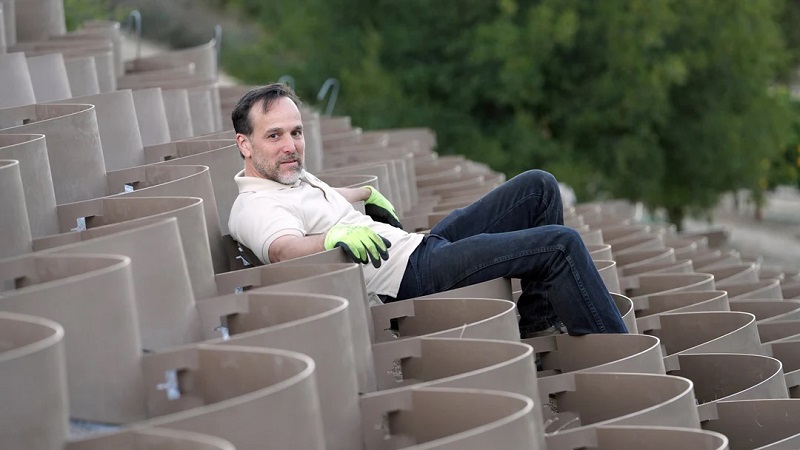
Trebilcock attempted to correct his hillside erosion problems with multiple commercially available products, but to no avail. He finally approached his problem like an engineer and crafted an elegant, cost-effective solution that has become the Dirt Locker, sustainable erosion control landscaping system.
Trebilcock understood that landslides were the result of long, wet seasons that fill up “pore spaces” within large masses of dry, hardened hillside soil. With sustained rains, hillsides become engorged with water, especially into their pore spaces, and the extra weight of the water creates pressure that eventually gives way to gravity causing landslides.
He knew that he needed a system that would provide year-round density for plants, trees and their root systems, thereby eliminating the pores that collect water during hard rains. With a healthy stabilized root structure, hillsides should be able to capture the rain water and allow it to pass through the plants subsystem, thereby locking in moisture, soil and nutrients keeping plants and trees healthy, and the ground below more stable.
The concept of capturing rainwater, locking in topsoil and nutrients, and blending seamlessly into a micro-environmental ecosystem, with an FDA approved food-grade plastic, is the genius of Dirt Locker. An added benefit is that the interlocking system creates convenient and safe access to steep hillsides once installed.
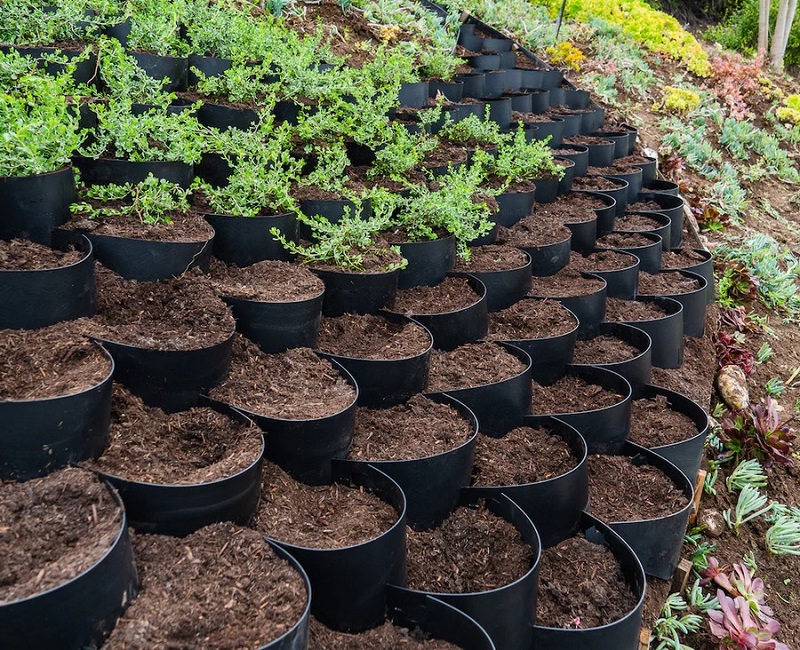
CAPTURE Rainwater: Reduce irrigation & preserve water
LOCK in Topsoil & Nutrients: Stop erosion & loss of fertilizer
PROVIDE an Optimal Ecosystem: Enable plants get more robust over time
CREATE a Series of Steps: Allow safe hillside access
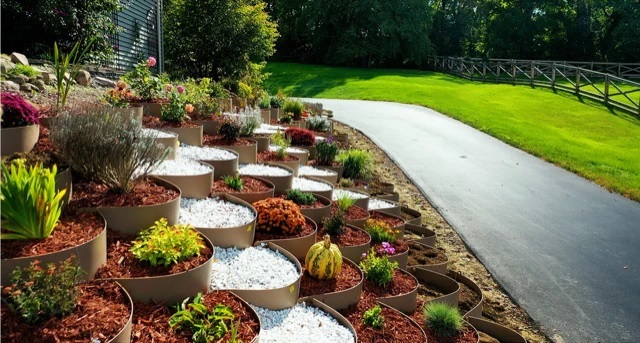
The patented Dirt Locker planter system, with its recycled, high-grade HDPE plastic, saves the equivalent of 13 plastic milk jugs from entering landfills and oceans.
Made domestically, and easily assembled, the Dirt Locker system requires no special tools or skills and can be DIY’ed for a stunning, series of terraced levels to beautify and maintain a stubborn hillside. Dirt Locker is committed to the environment and plants 6 trees for every 10 Dirt Lockers sold through the Eden Reforestation Projects.
Once installed, the Dirt Locker system allows native plants and trees to become acclimated and stabilized into the hillside by preventing “pore spaces”, as they create a denser ecosystem that allows native plants and trees to thrive, eliminating exposure to harsh elements.
The system has been proven across many different climates with harsh and challenging conditions, such as heavy rains, bitter winters, hurricane-level winds, and diverse soil conditions.
Unlike retaining walls, which weaken over time, the Dirt Locker system becomes structurally stronger as plants and trees strive. As plants grow and prosper, this coverage also gives the Dirt Locker plastic an added level of protection against harmful UV rays.
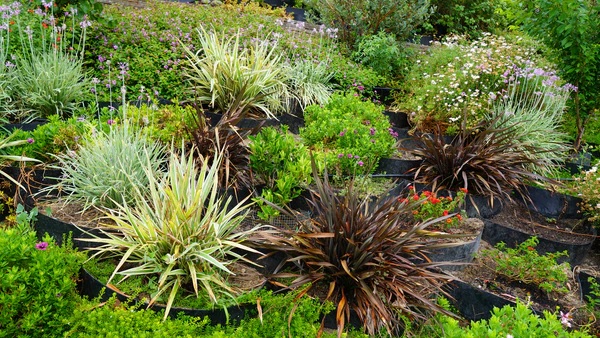
Another attractive trait of the Dirt Locker landscaping solution is that homeowners can first try their product on a small scale to test it out before committing to larger, more challenging sections of their properties. Smaller, initial projects can be helpful to get familiar with the overall process and will likely fuel creative ideas for more expansive, future projects.
Steps for Installing a Dirt Locker Landscaping System
Installing the Dirt Locker system does not require special skills or tools, as there are eight easy steps to follow:
- Step 1: Measure the Slope Angle and Size of Your Area
- Step 2: Review Obstacles
- Step 3: Create a Layout Plan
- Step 4: Choose the Side of the Collar Surface
- Step 5: Pre-Assemble the Dirt Locker System
- Step 6: Place the Dirt Locker System on Your Hillside
- Step 7: Backfill Each Dirt Locker Cell with Good Soil
- Step 8: Plant Your Desired Plants, Flowers, Trees and Shrubs
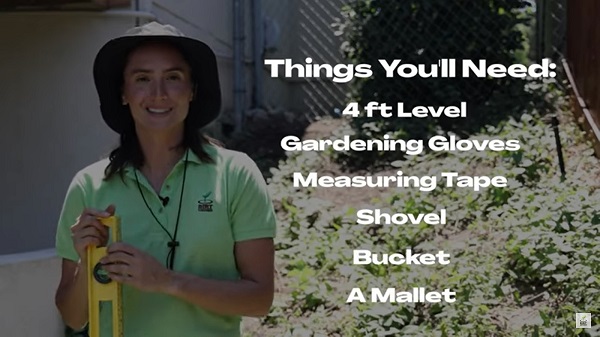
The video below goes over each step, as well:
For those needing creative assistance, Dirt Locker also offers a digital rendering design service to help you visualize the potential of your landscaping.
Step 1: Measure the Slope Angle and Size of Your Area
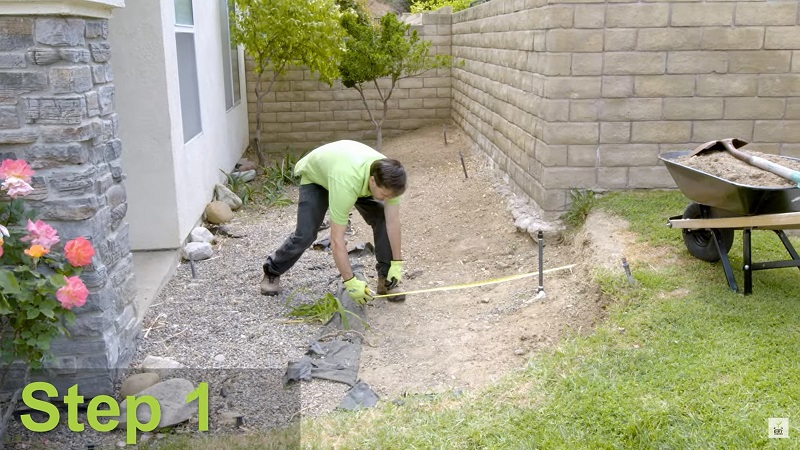
Measuring the slope of your hillside is critical to determine which sized Dirt Locker is best suited for your terrain. The video below gives a good overview of how to measure your slope, your area, and then how to use these metrics with Dirt Locker’s Project Estimator to calculate the number of system components necessary for your specific project.
Step 2: Review Obstacles
Review obstacles, such has mature trees and large boulders which must be factored into your overall landscape installation and design.
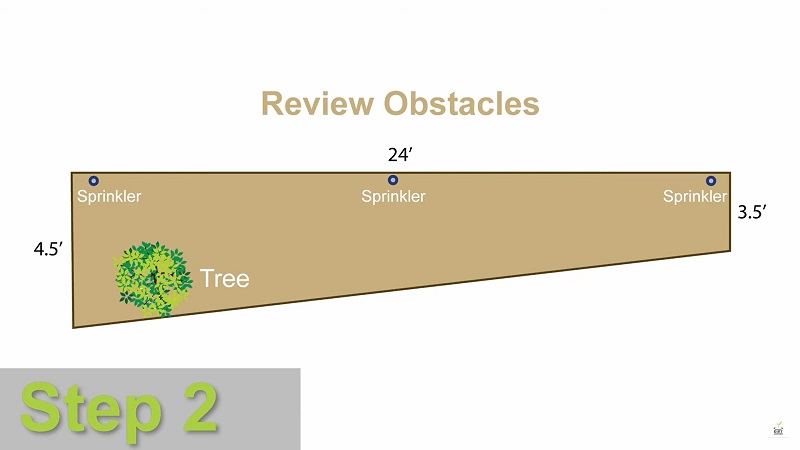
Step 3: Create a Layout Plan
Create a layout plan to understand visually what a post configured Dirt Locker system will look like before you begin.
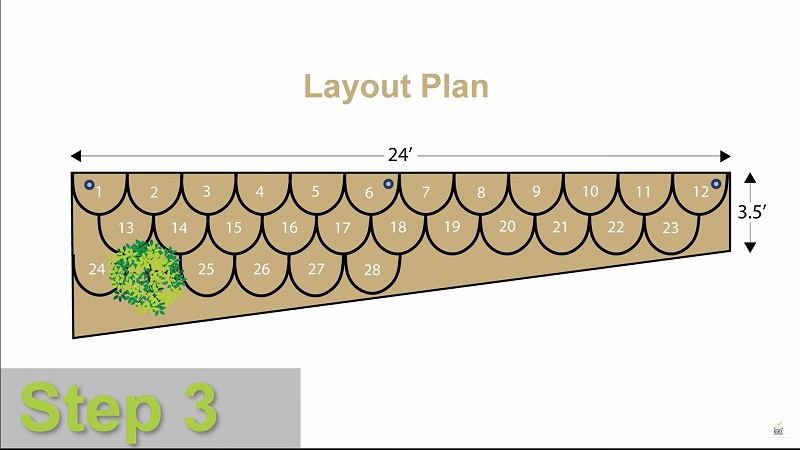
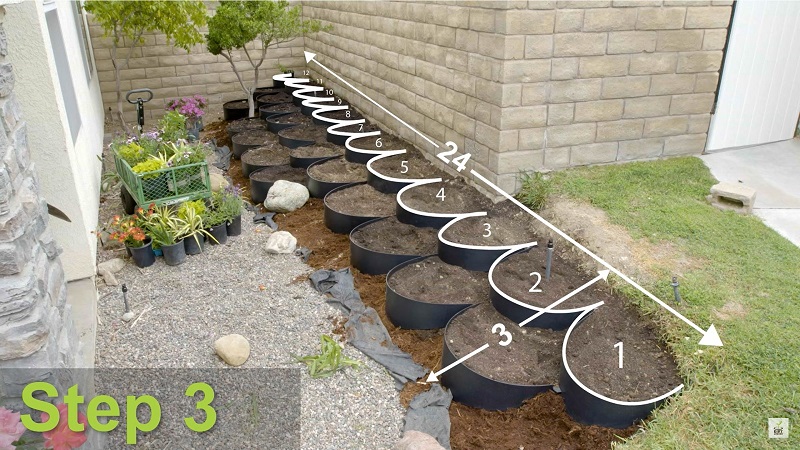
Step 4: Choose the Side of the Collar Surface
Choose the side of the Dirt Locker collar surface you prefer facing outward, either Matte finish or Glossy finish.
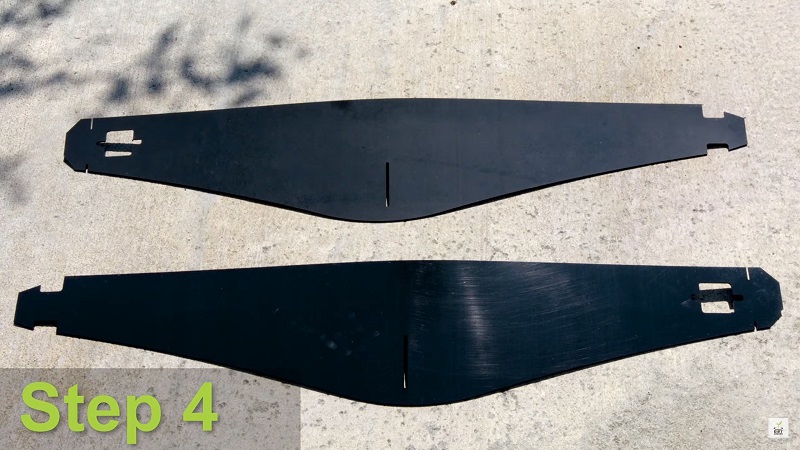
Step 5: Pre-Assemble the Dirt Locker System
Pre-assemble the Dirt Locker system on a flat surface by locking the cell tab of one Dirt Locker into the cell tab of the adjacent Dirt Locker. It’s that simple.
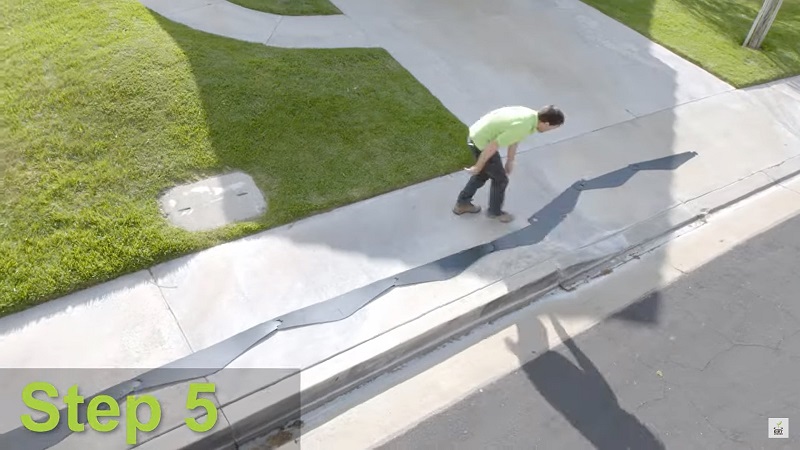
Step 6: Place the Dirt Locker System on Your Hillside
Pull the assembled Dirt Locker system and place it onto the desired location.
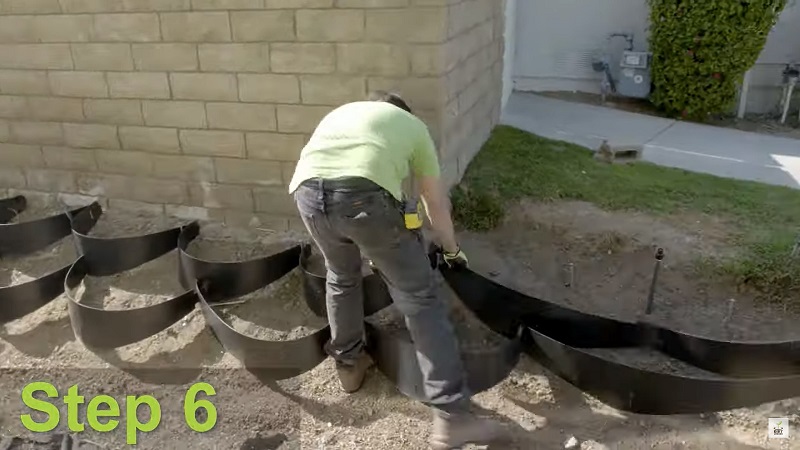
Step 7: Backfill Each Dirt Locker Cell with Good Soil
Backfill each Dirt Locker cell with good soil. Make sure that as you backfill, the cell is rounded in curvature, and level.
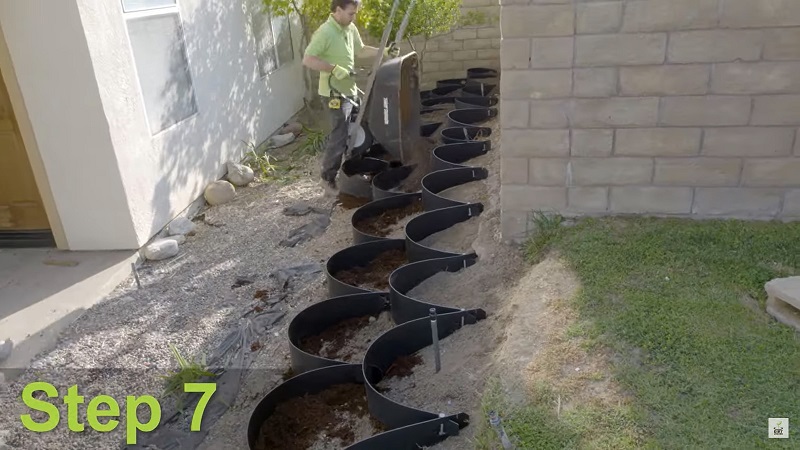
Step 8: Plant Your Desired Plants, Flowers, Trees and Shrubs
Plant your desired plants, flowers, trees and shrubs into your Dirt Locker cells.
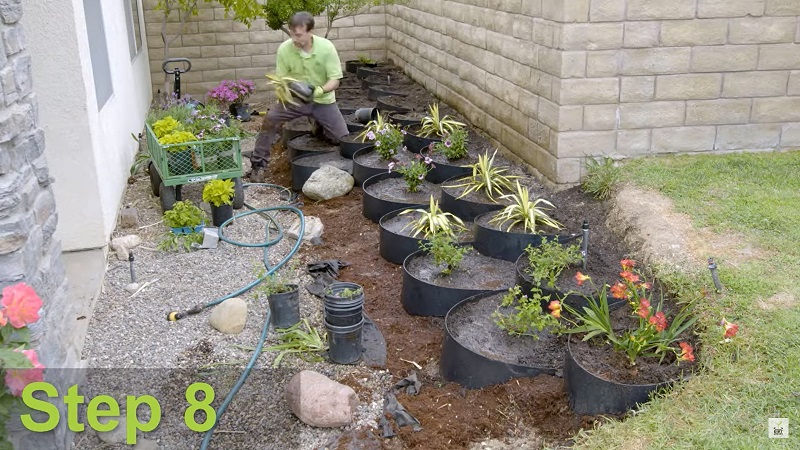
Make sure to leave some cells empty for gravel or stone to create steps that will allow you to walk up and down your hillside for maintenance or just enjoying your garden!
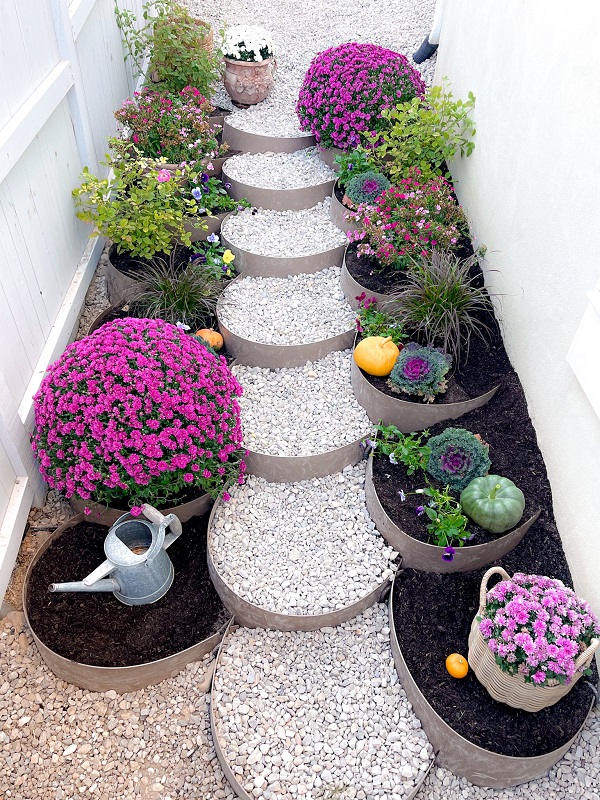
Best Plants for Hillsides and Erosion Control
When it comes to selecting plants for your Dirt Locker systems, there are several options to consider that are ideal for hillsides and erosion control. When selecting plants, shrubs, grasses and trees for your hillside, it’s important to choose types that are well-suited to your particular hillside environment, taking into account critical factors such as sunlight, soil type, and water availability.
Here are a few suggestions:
Groundcovers
Groundcovers are a great option for hillsides, as they help to stabilize the soil and prevent erosion. Juniper plants, like Blue Rug Juniper, are not only an excellent choice for planting on hills and slopes to control erosion, they also have the following additional beneficial traits:
- Hardiness: evergreen shrubs that thrive in most US growing zones
- Versatility: they add depth and color to any landscape
- Easy Care: deer resistant, salt tolerant, and extremely low maintenance
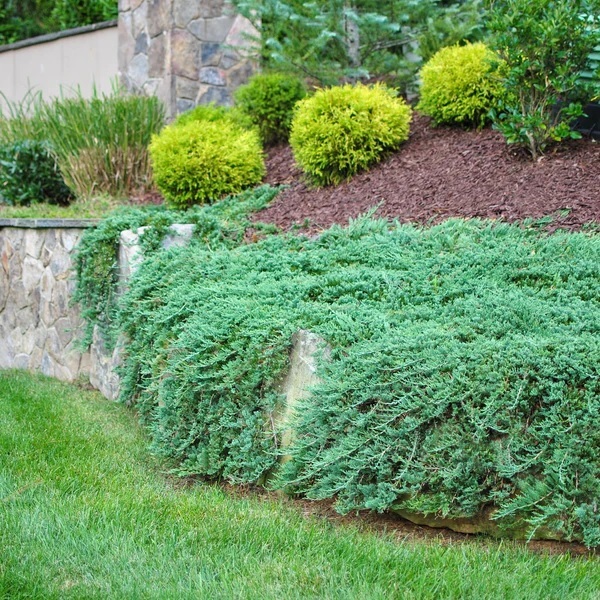
Sprawling Blue Rug Juniper groundcover from PlantingTree.com
Other groundcovers for erosion control to consider include creeping thyme, creeping phlox, and sedum.
Native Grasses
Native grasses are well adapted to their local environment and can help to prevent erosion. Good options include tall blue fescue grass, blue grama, buffalo grass, and switchgrass.
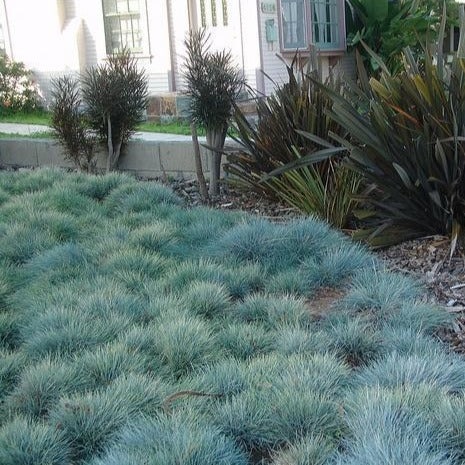
Beautiful Blue Fescue Grass from PlantingTree.com
Shrubs
Shrubs with deep roots can help to stabilize soil and prevent erosion. Some good options include serviceberry, sumac, and ninebark.
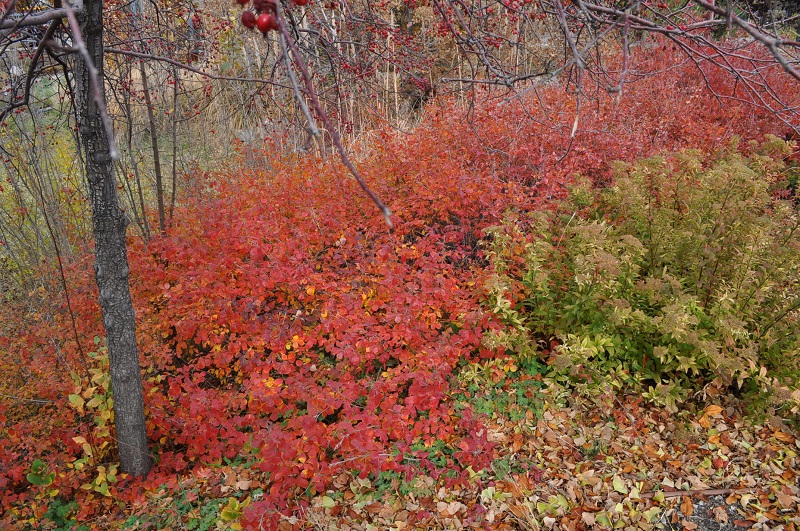
Gro-Low Sumac in the fall. Image courtesy of Conservation Garden Park
Perennials
Perennials with deep root systems can help to stabilize soil and prevent erosion. Some good options include coneflower, black-eyed Susan, and aster.

Black-Eyed Susans on landscaped hillside
Trees
Trees with deep roots can also help to prevent erosion on hillsides. Some good options include oak, hickory, and pine.
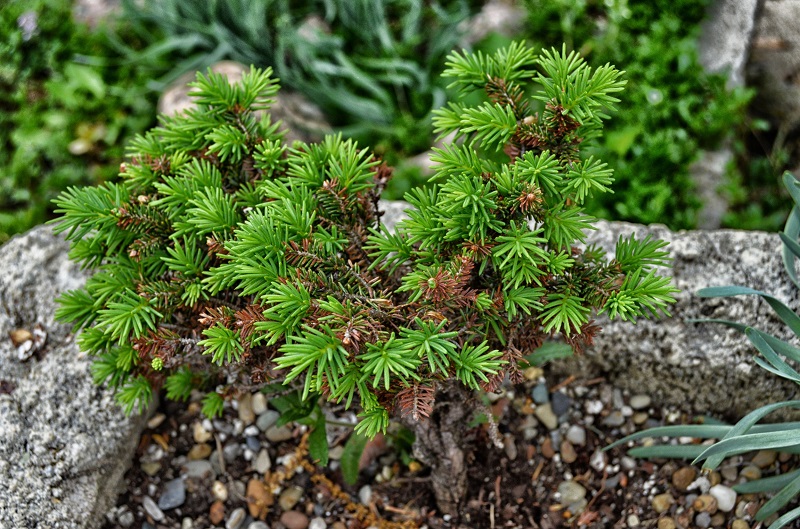
Small pine tree on landscaped hillside
Dirt Locker Resources
- Dirt Locker Website
- Dirt Locker Online Store
- Dirt Locker Project Estimator Tool
- Dirt Locker Installation Guide
- Dirt Locker Frequently Asked Questions
- Dirt Locker Hillside Digital Rendering Service
Dirt Locker Discount Promo Code
For any purchases on Dirt Locker, be sure to use the PURGULA5 discount promo code, to receive a 5% discount on your order.
More Recommended Landscaping & Gardening Articles
- How to Create a Thriving Pollinator Garden with These Plants & Trees
- Firescaping: How to Protect Your Home with Fire Resistant Landscapes
- The Traits & Risks of Dangerous Trees: Is Your Property Safe?
- Uber Apps for Lawn Care & Outdoor Services
- Best Garden & Landscaping Shows Now on Amazon Prime
- Pestie: The 411 on the Popular DIY Pest Control Subscription Service
- Pet Waste Removal: An Invaluable Healthy Home Service for Homeowners
- Related Topics: Gardening | Landscaping | Lawn Care | Home Wellness
| Purgula is reader-supported. When you click on links to other sites from our website, we may earn affiliate commissions, at no cost to you. If you find our content to be helpful, this is an easy way for you to support our mission. Thanks! Learn more. |

